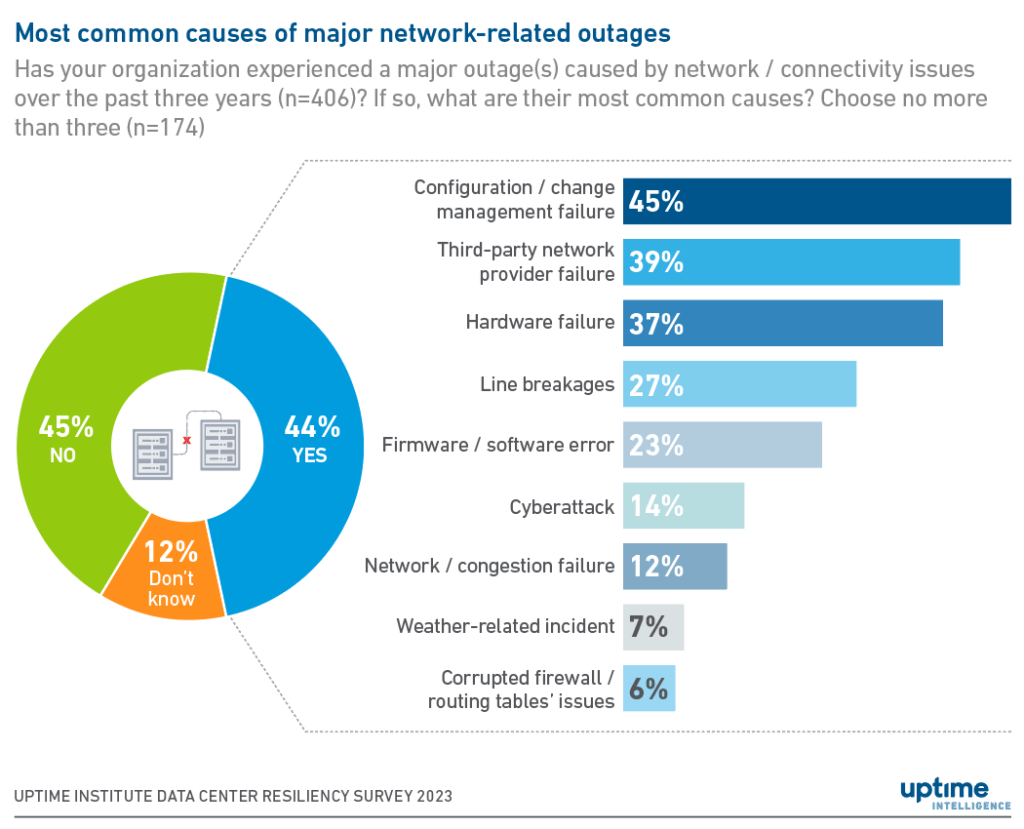As modern networks grow in complexity and scale, traditional manual management approaches are reaching their breaking point. The time-consuming and error-prone nature of manual configuration leaves networks vulnerable to downtime and security threats, directly impacting business outcomes.
Network automation offers a powerful solution to these challenges, leveraging advanced software-defined networking (SDN) principles to streamline operations, enhance agility, and improve reliability.
By automating repetitive tasks, reducing manual configurations, and orchestrating complex workflows, network automation empowers organizations to operate and manage their network efficiently.
What is Network Automation?
Network automation is the practice of leveraging software tools and coded scripts to replace manual tasks in the management and operations lifecycle of physical and virtual network devices.
Why is Network Automation Necessary?
The 2023 Uptime resiliency survey finds that the top cause of networking-related outages (around 45% of total outages) is configuration or change management failure due to human error. This ultimately results in capital loss due to increased downtime and also hinders the ability to scale.

Credit: 2023 Uptime resiliency survey
In essence, network automation helps network operators with the following:
- Automating repetitive tasks
- Eliminating errors in manual configurations
- Enhancing compliance
- Accelerating change management
- Scheduling changes and integrating with IT Service Management (ITSM) systems
- Standardizing configurations and protocols
- Managing infrastructure at scale
Thus, implementing network automation solutions is a game changer, improving the overall efficiency and scalability of the networking infrastructure.
Recommended Read: Key Considerations When Building Networks for Cloud Computing
What are the Key Components of Network Automation?
The key components of network automation consist of the following:
- Configuration Management: Instead of configuring hundreds of routers, switches, and firewalls with identical settings manually, network automation in configuration management principles such as 3A’s i.e. Authentication, Authorization, and Accounting (AAA), Dynamic Host Configuration Protocol (DHCP), etc., can be leveraged. It revolves around developing network device configurations into coded scripts that can be dynamically applied to devices across the whole infrastructure for consistency. This also helps in adhering to the same security policies and operational standards for multiple devices, minimizing human error and configuration inconsistencies.
- Provisioning: It involves setting up a network so that authorized users, devices, and servers can access it. Automated provisioning streamlines and speeds up the process of setting up new network devices and services, such as virtual machines, containers, or cloud instances, to meet evolving business requirements. Infrastructure as Code (IaC) principles, along with tools like AWS CloudFormation, help organizations to codify infrastructure configurations and provision resources programmatically, which promotes consistency and repeatability in deployment processes. One great example of automated provisioning is Ansible® Automation Platform which allows automating the integration and orientation of new devices into their network.
- Monitoring and Alerting: Automated monitoring refers to the continuous collection, analysis, and visualization of network telemetry data to detect performance gaps and vulnerabilities in real-time. Monitoring frameworks like Prometheus, and Grafana for visualization, offer a scalable and extensible solution for metric collection, alerting, and visualization, empowering organizations to implement custom monitoring dashboards and automated alerting workflows tailored to their specific needs.
- Reporting and Analysis: Automated reporting and analysis delivers associated stakeholders with data-driven actionable insights into network performance, capacity utilization, and security posture. Tools like ELK Stack (Elasticsearch, Logstash, Kibana) enable network managers to aggregate, index, and analyze log data from disparate sources, facilitating root cause analysis, compliance auditing, and trend forecasting through advanced search, visualization, and machine learning capabilities.
- Security Management: Automation plays a leading role in enhancing network security by automating threat detection, incident response, and vulnerability remediation processes. Security Orchestration, Automation, and Response (SOAR) platforms like Demisto or Phantom allow organizations to integrate security tools, orchestrate workflows, and automate incident response playbooks, which reduces mean time to detect (MTTD) and respond (MTTR) to security incidents along with ensuring compliance with regulatory requirements.
How to Choose the Right Network Automation Tools for Your Organization?
We recommend following this guideline for choosing the right automation tools and narrowing down the tools list:
Requirements Analysis: Different tools cater to different needs of the businesses. To narrow down the list of possible automation tools, it is crucial to list down your specific requirements and compare them with the features offered by automation tools. With multiple network automation tools in the market, choose the one that fits your organization’s hardware and solves your current needs and future scalability goals.
Assessing the tool’s compatibility and integration: Check if the automation tool integrates with your existing network infrastructure. Compatibility with APIs, software platforms, operating systems, and devices is essential for ensuring seamless integration and supporting desired operational functionalities. Here, open-source automated tools offer versatility and compatibility for a broad range of network operations, enabling easy integration. The cost comparison is another factor to narrow the list further.
Evaluation of scalability and versatility: Scalability is a crucial factor, and your network automation tool must allow expansion according to the growth of your infrastructure. Shortlist such tools that power scalable and optimized solutions without compromising performance, credibility, and the tool’s ability to streamline network traffic, reduce latency, and enhance throughput.
Security and Compliance Considerations: Security is a significant concern for organizations, especially when there are prevalent widespread cybersecurity threats. Look for tools with advanced features such as encryption capabilities, access control mechanisms, and threat detection and prevention functionalities.
Vendor Support and Training: Ensure the vendor provides adequate support and training resources to help your team troubleshoot and maximize the tool’s potential. It’s a crucial factor that also accounts for reduced maintenance costs in the long run.
#Pro Tip: Conduct trials or pilots to see how well the tools integrate with your existing systems and meet your performance expectations.
Network Automation Tools and Solutions
Below are the key network automation tools and solutions:
- Programming Languages: Python is considered the de facto language for network automation, due to its simplicity, readability, and extensive ecosystem of libraries and frameworks (e.g., Paramiko, Netmiko, NAPALM) tuned for vast network automation tasks such as device configuration, monitoring, and analysis. Similarly, growing languages like Go or Rust offer good performance advantages for building scalable and robust network automation applications, particularly in cloud-native or edge computing environments.
- Configuration Management Tools: In addition to Ansible and Puppet, emerging tools like SaltStack or Chef Habitat promote innovative approaches to configuration management, leveraging agentless architectures, distributed key-value stores, or application-centric workflows to automate configuration drift detection, remediation, and versioning across hybrid cloud and multi-cloud environments.
- Network Programming Frameworks: Open-source frameworks like OpenDaylight, Nornir, or ONOS (Open Network Operating System) provide programmable abstractions and APIs for orchestrating network functions and services, enabling organizations to build custom network automation solutions tailored to their unique requirements, whether in the traditional data center, SDN (Software-Defined Networking), or NFV (Network Function Virtualization) environments.
- Network Management Platforms (NMPs): Modern NMPs like Zabbix or Observium offer built-in automation features for auto-discovery, auto-registration, and auto-remediation of network devices and services, leveraging SNMP (Simple Network Management Protocol), ICMP (Internet Control Message Protocol), or RESTful APIs for seamless integration with existing infrastructure and toolchains.
Read More: The Role of RDMA over Converged Ethernet (RoCE) in AI Workloads
Should You Choose Open-Source Network Automation Tools?
Open-source network automation tools have become a popular choice for organizations seeking transparent, agile, and cost-effective solutions. Their open nature fosters continuous innovation through community-driven development, often resulting in lower total cost of ownership (TCO). Additionally, the flexibility of open-source tools empowers organizations to customize and modify solutions to meet specific and complex needs.
While commercial tools may offer more comprehensive, out-of-the-box features and dedicated vendor support, they may come at a higher cost and with less customization flexibility.
Both open-source and commercial tools provide valuable options for organizations seeking to streamline network operations and achieve their automation goals. The best choice ultimately depends on your organization’s specific needs and priorities, balancing budget, technical resources, desired features, and long-term goals.
Benefits of Network Automation
Below are the key benefits of network automation:
| Benefit | Description |
|---|---|
| Increased Efficiency | By automating repetitive tasks and workflows, organizations can achieve remarkable levels of operational efficiency, enabling IT firms to instead focus more on strategic initiatives such as infrastructure modernization, service innovation, or DevOps adoption, driving business agility and competitive differentiation in dynamic markets. |
| Reduced Errors | Network automation minimizes the risk of human error that’s common in manual configuration changes or troubleshooting procedures. It provides consistency, reliability, and compliance with industry standards and best practices (e.g., CIS Benchmarks, NIST Cybersecurity Framework) across the network infrastructure. |
| Improved Scalability | Rapid provisioning, scaling, and dispatching of network resources in response to fluctuating demand is another advantage of automation, enabling organizations to adapt to evolving business requirements, market dynamics, and technological advancements with agility and confidence. |
| Enhanced Security | Network automation eases problem identification and resolution through real-time telemetry data analysis, root cause correlation, and automated remediation workflows, minimizing service downtime, optimizing mean time to resolution (MTTR), and enhancing end-user experience and satisfaction. Scripts are used to automate risk scanning and patch deployment across all network devices, ensuring that security vulnerabilities are identified and addressed promptly. Additionally, automation can enforce access control policies and automate security audits, further adding to the network’s defenses. |
| Faster Troubleshooting | Network automation tools also improve troubleshooting by automating tasks like data collection, log analysis, and device diagnostics. Scripts can be designed to pinpoint the root cause of problems quickly, allowing network administrators to resolve issues faster and minimize downtime. |
| Improved Network Visibility | Automated reporting provides meaningful insights into the overall network performance. Network automation can generate detailed reports on network health, bandwidth utilization, latency, and other critical metrics. This real-time visibility helps network administrators identify performance bottlenecks, proactively address potential problems, and make data-driven decisions for network optimization. |
The Future of Network Management
A recent survey by Gartner from 2022 says:
- 85% of organizations expect to automate in the next 2-3 years
- 70% of organizations will implement automation by 2025, an increase of 20% from 2021
The future opportunities are ahead with network automation to rapidly transform network management. By leveraging automation tools and solutions such as Ansible’s Automation Platform, organizations are streamlining network operations to enhance efficiency and ensure a more robust and secure network environment.
Machine learning (ML) and artificial intelligence (AI) play a significant role in network automation. ML algorithms can be used to overview network data, identify patterns, and predict potential issues. This promotes protective network management and self-healing capabilities, where the network can automatically adjust configurations or take corrective actions based on real-time data analysis.
Intent-Based Networking (IBN) also playing a bigger role within network automation. It is a controller-based approach to network management that shifts the focus from manual device configuration to defining desired business outcomes, allowing the network to automatically adapt and self-manage to achieve those outcomes consistently across the infrastructure. At a high level, it enables organizations to focus their engineering resources on business outcomes rather than low-level configurations.
Cloud-Based Network Automation is also rising fast where network automation tools will be increasingly delivered as cloud-based services. This offers several benefits, including scalability, on-demand access, and simplified deployment. Network administrators will be able to virtually manage and automate their networks conveniently from anywhere, anytime with the application of SDNs.
Conclusion
Network automation’s expanding role in modern network management signifies a paradigm shift in how organizations approach their network infrastructure.
By leveraging automation tools, network administrators can free themselves from time-consuming manual tasks, gain valuable network analytics for strategic decisions, and build a more secure, foundational, and future-proof network infrastructure.
As technology continues to advance, network automation will undoubtedly play an even more pivotal role in shaping the future of networking.
About Hardware Nation:
Hardware Nation is a professional services company that accelerates network transformation through an open networking approach, enabling freedom of choice, flexibility, and cost efficiency. Our seasoned experts have worked on projects for some of the world’s leading organizations, leveraging a hybrid cloud-first and AI-enabled approach. We help our customers navigate the ecosystem, drawing on decades of experience. Our deployments are powered by leading white box and OEM network, compute, and storage vendors. Our expertise encompasses a wide range of industries and use cases, including enterprise, cloud, data center, AI, 5G/ISP infrastructure, and edge IT.
Alex Cronin
Co-Founder and Solutions Architect
Alex Cronin is a seasoned Solutions Architect with over 15 years of experience in networking and disaggregated infrastructure. His career is defined by aligning enterprise technology with business needs across diverse market segments, from emerging startups to Fortune 500 companies. He has worked on digital infrastructure projects covering network design and software solutions for data center operators, service providers, and enterprises. He is continuously collaborating with Hardware Nation Labs R&D to explore and pioneer the latest advancements in open networking and is assessing the applicability of AI/ML technology across enterprise, data center, and service provider infrastructures.
Rahul Narwal
Content Writer
Rahul is a content writer passionate about AI and software development, blending creativity with technical expertise. He creates engaging articles, visuals, and research papers in collaboration with seasoned experts, simplifying complex topics for both technical and non-technical audiences.




